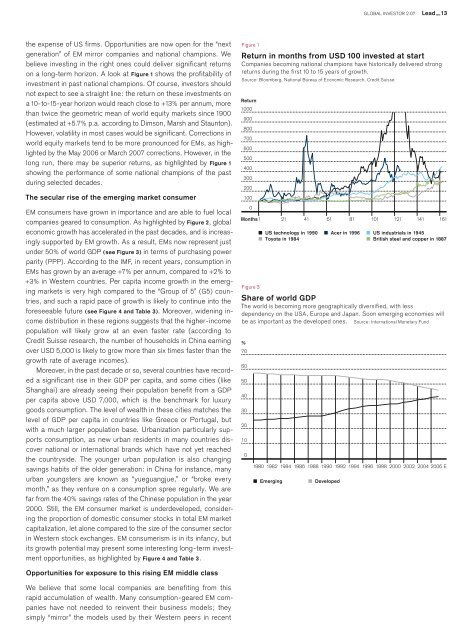You also want an ePaper? Increase the reach of your titles
YUMPU automatically turns print PDFs into web optimized ePapers that Google loves.
GLOBAL INVESTOR 2.07 Lead — 13<br />
the expense of US firms. Opportunities are now open for the “next<br />
generation” of EM mirror companies and national champions. We<br />
believe investing in the right ones could deliver significant returns<br />
on a long-term horizon. A look at Figure 1 shows the profitability of<br />
investment in past national champions. Of course, investors should<br />
not expect to see a straight line: the return on these investments on<br />
a 10-to-15-year horizon would reach close to +13% per annum, more<br />
than twice the geometric mean of world equity markets since 1900<br />
(estimated at +5.7% p.a. according to Dimson, Marsh and Staunton).<br />
However, volatility in most cases would be significant. Corrections in<br />
world equity markets tend to be more pronounced for EMs, as highlighted<br />
by the May 2006 or March 2007 corrections. However, in the<br />
long run, there may be superior returns, as highlighted by Figure 1<br />
showing the performance of some national champions of the past<br />
during selected decades.<br />
The secular rise of the emerging market consumer<br />
EM consumers have grown in importance and are able to fuel local<br />
companies geared to consumption. As highlighted by Figure 2, <strong>global</strong><br />
economic growth has accelerated in the past decades, and is increasingly<br />
supported by EM growth. As a result, EMs now represent just<br />
under 50% of world GDP (see Figure 3) in terms of purchasing power<br />
parity (PPP). According to the IMF, in recent years, consumption in<br />
EMs has grown by an average +7% per annum, compared to +2% to<br />
+3% in Western countries. Per capita income growth in the emerging<br />
markets is very high compared to the “Group of 5” (G5) countries,<br />
and such a rapid pace of growth is likely to continue into the<br />
foreseeable future (see Figure 4 and Table 3). Moreover, widening income<br />
distribution in these regions suggests that the higher-income<br />
population will likely grow at an even faster rate (according to<br />
Credit Suisse research, the number of households in China earning<br />
over USD 5,000 is likely to grow more than six times faster than the<br />
growth rate of average incomes).<br />
Moreover, in the past decade or so, several countries have recorded<br />
a significant rise in their GDP per capita, and some cities (like<br />
Shanghai) are already seeing their population benefit from a GDP<br />
per capita above USD 7,000, which is the benchmark for luxury<br />
goods consumption. The level of wealth in these cities matches the<br />
level of GDP per capita in countries like Greece or Portugal, but<br />
with a much larger population base. Urbanization particularly supports<br />
consumption, as new urban residents in many countries discover<br />
national or international brands which have not yet reached<br />
the countryside. The younger urban population is also changing<br />
savings habits of the older generation: in China for instance, many<br />
urban youngsters are known as “yueguangjue,” or “broke every<br />
month,” as they venture on a consumption spree regularly. We are<br />
far from the 40% savings rates of the Chinese population in the year<br />
2000. Still, the EM consumer market is underdeveloped, considering<br />
the proportion of domestic consumer stocks in total EM market<br />
capitalization, let alone compared to the size of the consumer sector<br />
in Western stock exchanges. EM consumerism is in its infancy, but<br />
its growth potential may present some interesting long-term investment<br />
opportunities, as highlighted by Figure 4 and Table 3.<br />
Figure 1<br />
Return in months from USD 100 invested at start<br />
Companies becoming national champions have historically delivered strong<br />
returns during the first 10 to 15 years of growth.<br />
Source: Bloomberg, National Bureau of Economic Research, Credit Suisse<br />
Return<br />
1000<br />
900<br />
800<br />
700<br />
600<br />
500<br />
400<br />
300<br />
200<br />
100<br />
0<br />
Months1<br />
21 41 61 81 101 121 141 161<br />
Figure 3<br />
US technology in 1990<br />
Toyota in 1984<br />
Acer in 1996 US industrials in 1945<br />
British steel and copper in 1887<br />
Share of world GDP<br />
The world is becoming more geographically diversified, with less<br />
dependency on the USA, Europe and Japan. Soon emerging economies will<br />
be as important as the developed ones. Source: International Monetary Fund<br />
%<br />
70<br />
60<br />
50<br />
40<br />
30<br />
20<br />
10<br />
0<br />
1980 1982 1984 1986 1988 1990 1992 1994 1996 1998 2000 2002 2004 2006 E<br />
Emerging<br />
Developed<br />
Opportunities for exposure to this rising EM middle class<br />
We believe that some local companies are benefiting from this<br />
rapid accumulation of wealth. Many consumption-geared EM companies<br />
have not needed to reinvent their business models; they<br />
simply “mirror” the models used by their Western peers in recent

















